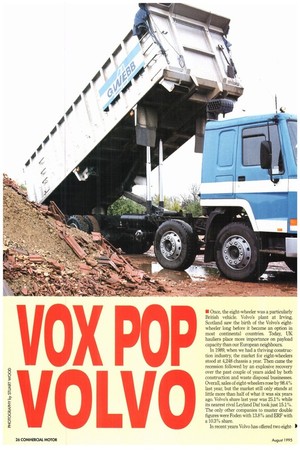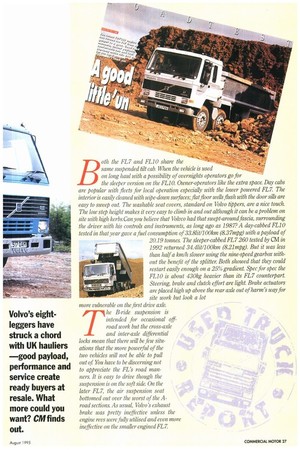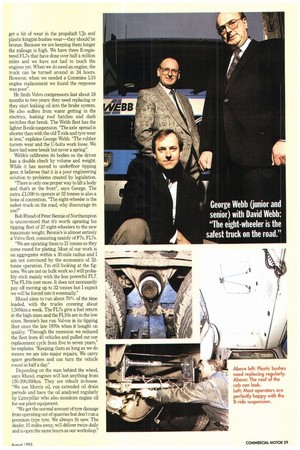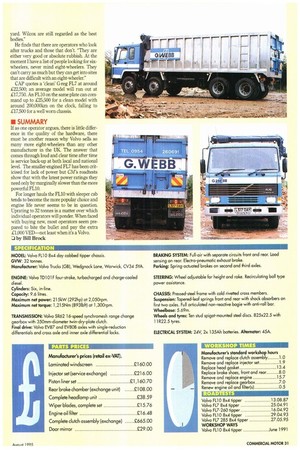• Once, the eight-wheeler was a particularly British vehicle. Volvo's
Page 118

Page 119

Page 120

Page 121

Page 122

Page 123

If you've noticed an error in this article please click here to report it so we can fix it.
plant at Irving, Scotland saw the birth of the Volvo's eightwheeler long before it became an option in most continental countries. Today, UK hauliers place more importance on payload capacity than our European neighbours.
In 1989, when we had a thriving construction industry, the market for eight-wheelers stood at 4,248 chassis a year. Then came the recession followed by an explosive recovery over the past couple of years aided by both construction and waste disposal businesses. Overall, sales of eight-wheelers rose by 98.4% last year, but the market still only stands at little more than half of what it was six years ago. Volvo's share last year was 25.1% while its nearest rival Leyland Daf took just 15.1%. The only other companies to muster double figures were Foden with 13.8% and ERF with a 10.3% share.
In recent years Volvo has offered two eight
Volvo's eightleggers have struck a chord with UK hauliers good payload, performance and service create ready buyers at resale. What more could you want? CM finds out.
same suspended tilt cab. When the vehicle is used on long haul with a possibility of overnights operators go for
the the
version on the FL10. Owner-operators like the extra space Day cabs are popular with fleets for local operation especially with the lower powered FL7 The interior is easily cleaned with wipe-down surfaces; flat floor wells flush with the door sills are easy to sweep out. The washable seat covers, standard on Volvo tippers, are a nice touch. The low step height makes it very easy to climb in and out although it can be a problem on site with high kerbs. Can you believe that Volvco had that swept-around fascia, surrounding the driver with his controls and instruments, as long ago as 1987? A day-cabbed FLIO tested in that year gave a fuel consumption of 33.81ita 00km (8.37mpg) with a payload of 20.19 tonnes. The sleeper-cabbed FL7260 tested by CM in 1992 returned 34.41u/100km (8.21mpg). But it was less than half a km/h slower using the nine-speed gearbox without the benefit of the splitter Both showed that they could restart easily enough on a 25% gradient. Spec for spec the FL10 is about 430kg heavier than its FL7 counterpart. Steering, brake and clutch effort are light. Brake actuators are placed high up above the rear axle out of harm's way for site work but look a lot more vulnerable on the first drive axle.
The B-ride suspension is intended for occasional offroad work but the cross-axle and inter-axle differential locks mean that there will be few situations that the more powerful of the two vehicles will not be able to pull out of You have to be discerning not to appreciate the FL's road manners. It is easy to drive though the suspension is on the soft side. 072 the later FL7, the air suspension seat bottomed out over the worst of the Aroad sections. As usual, Volvo's exhaust brake was pretty ineffective unless the engine revs were fully utilised and even more ineffective on the smaller engined FL7
leggers, the FL7 and the FL10, to give a range of power options. The smaller-engined FL7 is best suited to local tipping work while the larger-engined FLIO is better for longer bulk haulage operations.
• EVOLUTION
Towards the end of 1985 the F7 eight-wheeler gave way to the low-height FL cab models. First the 8x4 FL10 appeared in September with its 9.6-litre charge-cooled straight six rated at 223kW( 299hp).
Two months later, the FL7 8x2 and 8x4 powered by a charge-cooled 6.7-litre six-cylinder engine rated at 183kW(245hp) made their entrance. They both used the same eightspeed synchromesh range-change gearbox. Less than three years later, at the beginning of 1988, it was replaced by the R1000 nine-speed box and R1400 14-speed transmission.
At the same time, the FL10 had an increase in power with the introduction of the TD102F engine. Although it was still 9.6 litres and six pots, output was 237kW(318hp). Against Volvo's better judgement operators demanded an uplift in the specification. It came in October 1990 with a heated suspension seat with head restraints for the driver and electric windows. At the same time, the FL7 also received still more power-191kW(256hp) in the shape of the TD73ES while the FL10 with a revised TD102FM engine was rated at 231kW (310hp). The latter has since been superceded by the TD103ES producing 235kW(320hp), and sporting electronic diesel control. Both engines meet the Euro-1 emission standard.
Since the late 80s, the shorter and lighter Bride suspension has largely displaced the wider spread multi-spring T-ride bogie suspension, although it still remains available. At TipCon this year the FL7 gained more new engines, including a six-cylinder Euro-1 unit rated at 285hp.
• OPERATORS
David and George Webb's mixed fleet of eight. wheelers cover a high mileage. Once the company's operation concentrated on local site work in Cambridgeshire. Today, the trucks travel much further afield and clock up some 80,000 miles a year each. The company, established by their father just before the second world war, has 21 vehicles—three Foden 4000s, two Foden 3000s, two Scania 113s and 14 Volvo FL7 and FL10s.
"We had to tighten up through the recession but we started to buy new again at the end of 1993. We bought a couple of Mercs secondhand when we needed a bit of extra capacity in a hurry but replaced them with the Foden 3000s. The Scanias are recent additions and we are very pleased with them," George told us. "The Fodens run rings around our Volvos but the latest FL7 285 is very good, it works as well as the FL10s. But we buy Volvos because of the backup. Dufflelds are as good as you can get. Most of the trucks are serviced on contract maintenance but three are on preventative maintenance. At the moment there does not seem to be much between the costs of the two. With preventative maintenance you could be faced with an unexpected bill if something major brakes. Contract maintenance means we can predict our running costs more certainly.
"We uprated the FL7s to 31 tonnes and gained half a tonne in payload but we have switched to the FL1Os with a sleeper cab for the full 32-tonne operation to maintain productivity. They are a bit quicker and carry a 27m3 body instead of a 25m3. But we have had to go to under-floor tip gear to get the weight distribution."
Webb has bought Volvos for a good number of years but not without a break. "We fell out over the torque converters on some F7s back in 1979," explains George.
"They were the early automatics before the current Geartronic. We were having serious problems with clutch wear and downtime. Volvo didn't want to know. Allison got to hear of our plight, but we had sold most of them by then. They changed the boxes on our last three. We bought seven or eight Leyland Dais after that.
"Reliability is unbelievably good today. We get a bit of wear in the propshaft U,Is and plastic kingpin bushes wear—they should be bronze. Because we are keeping them longer the mileage is high. We have three E-registered FL7s that have done over half a million miles and we have not had to touch the engines yet. When we do need an engine, the truck can be turned around in 24 hours. However, when we needed a Cummins L10 engine replacement we found the response was poor".
He finds Volvo compressors last about 18 months to two years: they need replacing or they start leaking oil into the brake system. He also suffers from water getting in the electrics, leaking roof hatches and dash switches that break. The Webb fleet has the lighter B-ride suspension. "The axle spread is shorter than with the old T-ride and tyre wear is less," explains George Webb. "The rubber turrets wear and the U-bolts work loose. We have had some break but never a spring".
Webb's calibrates its bodies so the driver has a double check by volume and weight. While it has moved to underfloor tipping gear, it believes that it is a poor engineering solution to problems created by legislation.
"There is only one proper way to lift a body and that's at the front", says George. The extra £1,000 to operate at 32 tonnes is also a bone of contention. "The eight-wheeler is the safest truck on the road, why discourage its use?"
Bob Rhead of Peter Bennie of Northampton is unconvinced that it's worth uprating his tipping fleet of 27 eight-wheelers to the new maximum weight. Bennie's is almost entirely a Volvo fleet, consisting mainly of F7s, FL7s.
"We are uprating them to 31 tonnes as they come round for plating. Most of our work is on aggregates within a 30-mile radius and I am not convinced by the economics of 32tonne operation. I'm still looking at the figures. We are not on bulk work so I will probably stick mainly with the less powerful FL7. The FL1Os cost more. It does not necessarily pay off moving up to 32 tonnes but I expect we will be forced into it eventually"
Rhead aims to run about 70% of the time loaded, with the trucks covering about 1,500km a week. The FL7s give a fuel return in the high sixes and the FL10s are in the low sixes. Bennie's has run Volvos in its tipping fleet since the late 1970s when it bought on quality. "Through the recession we reduced the fleet from 40 vehicles and pulled out our replacement cycle from five to seven years," he explains. 'Keeping them as long as we do means we are into major repairs. We carry spare gearboxes and can turn the vehicle round in half a day" Depending on the man behind the wheel, says Rhead, engines will last anything from 150-300,000km. They are rebuilt in-house. "We use Morris oil, run extended oil drain periods and have the oil analysed regularly by Caterpillar who also monitors engine oil for our plant equipment.
"We get the normal amount of tyre damage from operating out of quarries but don't run a premium type tyre. We always fit new. The dealer, 15 miles away, will deliver twice daily and is open the same hours as our workshop." After five
454 years the Volvo A . .. is still worth coo 00;1 something. "The word soon tell 0 () . gets around when we have a truck for sale. We sell them complete with body and tipping gear. We still look at other makes but we have no reason to change at the moment".
Tony Spencer operates a fleet of 22 vehicles for BOCM Pauls of Bamber Bridge who manufacture and distribute animal feed products for farmers. Its a mixed fleet with a couple of inherited ERFs and a couple of Seddon Atkinsons, and includes nine eight-wheelers, including FL7 and FL10s. "The eight-wheeler gives us the best compromise between access and weight and is a major factor in the choice of vehicle. We buy Volvos principally for the dealer service back-up," says Spencer.
In pure hardware terms, he says, there is not a lot to choose between the different makes. He keeps his trucks for about seven years; that's another reason for buying Volvos. "The engines are meaty enough to stand up to the work. We operate tipper blowers so the engines do 30-40% more work than the 120,000Icm on the clock indicates. Fuel consumption is important to us but it will mean little to you in terms of mpg."
In his time at BOCM Pauls, he has had to change only two gearboxes across the whole fleet and never had to rebuild an engine. All the vehicles are on contract maintenance, except for the late ones which are on contract hire through the local dealer and Volvo. "Thomas Hardy gives us very good service maintaining our vehicles overnight and at weekends and gets them back into service the next day," says Spencer.
Four of his Volvo eightwheelers are 8x2s with lift-up rear axles to give extra manoeuvrability needed to get through farm gates with access designed for the horse and cart. Fitting Pirelli and Goodyear tyres eliminated shouldering "We then found we were getting a lot of shoulder wear on the tyres fitted to the second steer axle. We were having to replace them at twice the rate of the front steer axle". To its credit, he says, Volvo stepped in and quickly solved the problem. With the steering geometry set up for eight wheels, lifting the rear axle put an extra load on the second steering axle. We have had no trouble since the steering angles were reset. Uprating to 32 tonnes is not an option with the lift axle but we will take advantage of it with new vehicles.
He has never had any problem selling Volvos. "Normally we sell to the trade or to third parties contracted to us. In terms of reliability and time on the road the Volvos are better than other makes of vehicles in our fleet."
• DEALERS
Ian Thompson, the sales manager for Volvo main dealer Darlington Commercials, sells FL7 and FL10 eight-wheelers in about equal numbers "The construction market may still be declining but you can't get good used eightleggers for love nor money," he says. There were good secondhand examples about in 1992, Thompson says. He is still on the look out for them but the supply has almost dried up. "The condition of the body and the tip gear mountings are points to look out for, but otherwise the general appearance will be a good indication of how hard it's been worked. Some operators have uprated the FL7 260s to 32 tonnes. The Bride bogie is quite adequate for normal on/off road use. It's generally operators on waste disposal work that go for the T-ride. Day cabs were mainly specified on the FL7s and sleeper cabs for the FL10s. With the move towards articulated vehicles for long-haul tipping operations the majority of eight-wheeler operators are fitting day cabs".
Tony Ferguson of Junction Ten Commercials, part of the Hartshorne group, specialises in used Volvos. He usually has about 30 trucks in stock which generally includes three of four eight-wheelers. "Owner-operators buy them because of the weight, ride and pulling power," he told CM. "The ride is one of the best and Volvo is good on parts and back-up. They are in great demand in the Midlands with the Black Country route being built. Good ones are few and far between he admits. "When we get one they don't stay long. Sometimes I've sold them on before they have come into the
yard. Wilcox are still regarded as the best bodies."
He finds that there are operators who look after trucks and those that don't. "They are either very good or absolute rubbish. At the moment! have a list of people looking for sixwheelers, never mind eight-wheelers. They can't carry as much but they can get into sites that are difficult with an eight-wheeler."
CAP quotes a 'clean' G-reg FL7 at around £22,500; an average model will run out at 17,750. An FL10 on the same plate can command up to £.25,500 for a clean model with around 200,000km on the clock, falling to £17,500 for a well worn chassis.
• SUMMARY
If as one operator argues, there is little difference in the quality of the hardware, there must be another reason why Volvo sells so many more eight-wheelers than any other manufacturer in the UK. The answer that comes through loud and clear time after time is service back-up at both local and national level. The smaller-engined FL7 has been crit icised for lack of power but roadtests show that with the latest power ratings they need only by marginally slower than the more powerful FL10.
For longer hauls the FL10 with sleeper cab tends to become the more popular choice and engine life never seems to be in question. Uprating to 32 tonnes is a matter over which individual operators will ponder. When faced with buying new most operators seem prepared to bite the bullet and pay the extra £1,000 VED—not least when it's a Volvo,
D by Bill Brock




























































































































